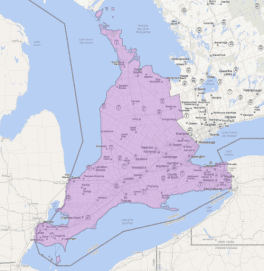Country Canada Postal code prefixes N Area 36,746 km² | Time zone EST (UTC−5) Area code(s) 519, 226, 905, 289 | |
 | ||
Migrant violence in canadian schools part two southwestern ontario
Southwestern Ontario is a secondary region of Southern Ontario in the Canadian province of Ontario, centered on the city of London. It occupies most of a peninsula that is bound on three sides by water: Lake Huron, including Georgian Bay, to the north and northwest; the St. Clair River, Lake St. Clair, and Detroit River, to the west; and Lake Erie to the south. To the east, on land, Southwestern Ontario is bounded by Central Ontario and the Golden Horseshoe. The region had a population of 2,504,878 in 2011.
Contents
- Migrant violence in canadian schools part two southwestern ontario
- Southwestern ontario s economy at a crossroads
- Weather and climate
- Single tier municipalities
- Separated municipalities
- Regional municipalities
- Counties
- References
Apart from London, other towns and cities in the core area of Southwestern Ontario include Chatham, Ingersoll, Sarnia, St. Thomas, Tillsonburg, Windsor, and Woodstock. Outside the core of Southwestern Ontario, cities located on or near the Grand River are also considered to be part of the extended Golden Horseshoe region that surrounds western Lake Ontario. They include Brantford, Cambridge, Guelph, Kitchener, and Waterloo.
Two subregions are recognisable with Southwestern Ontario. The Bruce Peninsula and Georgian Bay shoreline, including Owen Sound and the Blue Mountains, are also part of the Georgian Triangle. Cities and towns located more immediately north of London, including Stratford, Goderich, Wingham, Mount Forest, and Hanover, are considered part of the subregion of "Midwestern Ontario".
Southwestern Ontario was first settled by Europeans in the early 18th century, when it was part of the Royal Province of New France. One of the oldest continuous settlements in the region is Windsor, which originated as a southerly extension of the settlement of Fort Detroit in 1701. With the transfer of New France to British control in 1763, the region was part of the British Province of Quebec, 1774 to 1791; the Province of Upper Canada, 1791 to 1841; and the Canada West division of the Province of United Canada, 1841 to Confederation in 1867, when United Canada was formally partitioned into the provinces of Ontario and Quebec.
During the 19th century and early 20th century, the largest city in Southwestern Ontario was Windsor; however, as both cities grew, Windsor was outpaced by the faster growth of London, and passed the mantle of regional anchor to that city in the 1960s. Late in the 20th century the Kitchener-Cambridge-Waterloo area became the populous metropolitan area in southwestern Ontario.
Southwestern Ontario is a prosperous agricultural region whose chief crops are tobacco, sweet corn, soybean, winter wheat, canola, and tomatoes. Dairy and beef farming, breeding and training of standardbred horses and wine growing and production are also important industries. Its climate is among the mildest in Canada. Although brief periods of winter can be severe, summers are hot and humid with a longer growing season than in most of the country.
A large section of Southwestern Ontario was part of the Talbot Settlement, and the region has benefited from the settlement’s facilitation of agriculture and of trade in general. Its economy is heavily tied in with that of the midwestern United States, in particular the border state of Michigan. Auto manufacturing and parts, agriculture and hi-tech industries are key components of the region’s economy. The region also provides important transportation routes for commercial trucking, railway and tanker shipping from Detroit-Windsor and Port Huron, Michigan-Sarnia linking Canada with major markets in the eastern and midwestern United States.
Southwestern ontario s economy at a crossroads
Weather and climate
Like other parts of southern Canada, the region brings warm or hot summers with normal thunderstorm occurrences. Some of these storms are severe, with damaging winds, hail and tornadoes all possible during peak season, May through September. The most likely areas for these kinds of weather events is within the Windsor - London corridor and north up to about Huron County. Winters are cold with less snowfall in the south towards Essex County and higher amounts north towards Bruce County. London receives approximately 30% more snowfall than Windsor, owing to its relative position to Lake Huron and the resulting snowbelt in Bruce and Middlesex counties.
Under the Köppen climate classification, much of this area has a humid continental climate (Köppen Dfa/Dfb borderline).
